The year 2020 brought along many challenges in the business world and wider. While remote work has been on the rise for some time now, the sudden global pandemic was the key to making it such a widespread phenomenon.
Many companies were not ready to have their employees working from home, but telecommuting ended up saving their businesses. Since then, many employers, along with the employees, have been convinced that remote work is not so bad.
So, is it here to stay? How is it affecting productivity? Find out the answer to those and many more questions by looking at the remote work statistics and work-from-home trends below.
Here is which remote work statistics we will cover:
- Global Remote Work Statistics
- Remote Working Productivity Statistics
- Remote Work Benefits
- Remote Work From Home Statistics & Trends
- Remote Work Challenges
- Remote Workers Statistics
- Remote Hiring Statistic
- Real Estate & Telecommute Statistics
- Statistics On The Future Of Remote Work
Remote Work Stats (Editor’s Pick)
- 61% of remote workers have been working from home for over 12 months.
- 16% of the world’s companies are completely remote.
- 77% of workers say they are more productive working from home.
- 56% of the world’s companies allow remote work, 44% don’t.
- The average annual income of telecommuters is $4,000 higher.
- The number of employees working from home has gone up by 159%.
- Mobile phones are the biggest distraction for 56% of remote workers.
- 57% of remote workers are satisfied with their jobs.
- Employee turnover is 25% lower for companies that allow remote work.
- Post-pandemic, 65% of remote workers do not want to return to the office.
Global Remote Work Statistics
1. Research from June 2021 shows 61% of remote workers have been working from home for over 12 months.
To show that remote work is still on the rise, an OfficeNeedle study found that 61% of those who work from home have been doing so for over 12 months, while 22% of them have been doing so since December 2020 or later.
Source: OfficeNedle
2. In 2021, 16% of the world’s companies are completely remote, hiring only remote workers.
Sixteen percent of all the companies in the world are fully remote, according to remote working data by Owl Labs. This number is expected to grow in the future, so even fewer companies will have physical offices and headquarters.
Source: Owl Labs


Source: Owl Labs
3. Around the world, 44% of companies and brands do not allow remote work.
While this is a high number, 56% of all the companies in the world still allow remote work, which is more than half. The number could decrease as many companies faced remote work due to the COVID-19 pandemic.
Source: Owl Labs
4. The number of employees working from home has gone up by 159% since 2009.
(Global Workplace Analytics)
The innovation and advancement of technology allowed telecommuting to become a rising trend in the last decade or so. With technology, it is now easy to work from anywhere (WFA). Besides that, many employees and employers nowadays value a good work-life balance (including flexibility) when looking for a job more than anything else.
Source: Global Workplace Analytics
5. Before the COVID-19 pandemic, 4.7 million (or 3.4%) of the US workforce was already working from home.
Before the outbreak of the novel Coronavirus pandemic in 2020, 3.4% of the US workforce was already working from home, according to the US Bureau of Labor Statistics and the US Census Bureau research.
Source: FlexJobs


6. After the pandemic started, 88% of companies worldwide ordered or encouraged their employees to work from home.
The year 2020 is when the world went remote. Once the global pandemic was announced, the majority of organizations and businesses worldwide either encouraged or made it mandatory for their workers to stop coming into offices and work from home. According to Gartner’s study, 97% of all organizations also quit/canceled all work-related travel.
Source: Gartner
7. 52% of the global workforce works from home once a week, and 68% do it at least once a month.
The majority of the global workforce works remotely, at least to some extent. How remote work is organized will more or less differ for different companies and industries.
Source: Owl Labs
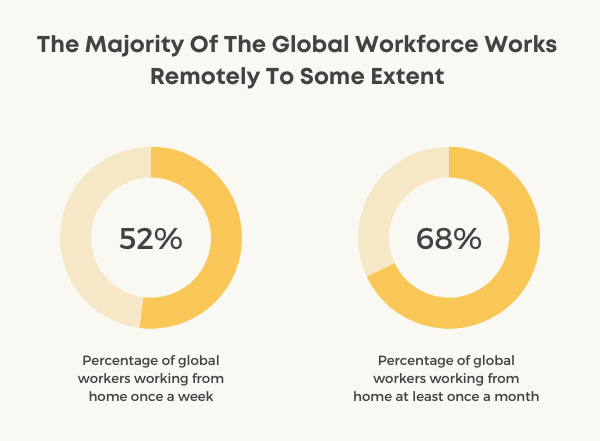

8. All departments are expected to have remote workers by 2028.
In less than a decade from now, many more industries are expected to offer remote working positions, making telecommuting an even more common occurrence in the business world.
Source: Upwork
9. Almost everyone (99%) would choose remote work for the rest of their life, even if just part-time.
This remote work statistic shows how desirable remote work is in the world of labor. Also, it comes as no surprise, as workers love to be offered flexibility.
Source: Buffer
10. 56% of the world’s companies allow remote work, 44% don’t.
While 44% of global companies and brands do not offer remote work to their employees, the majority of them allow their employees to work remotely.
Source: Owl Labs
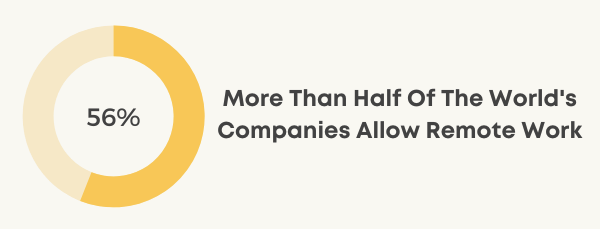

11. Between 2005 and 2018, remote work in the US has risen by 173%.
This piece of remote work US statistics shows us that remote work has been on the rise from the start of the 21st century.
Source: Global Workplace Analytics
12. In the EU, 12% of workers aged between 20 and 64 were working from home in 2020.
Remote work Europe statistics show us that the capital of Norway and two regions in Belgium recorded the highest share of remote workers from home in the same year.
Source: EU Labor Force Survey
13. At the start of 2021, 32% of Canadian workers (age 15-69) worked most of their hours from home.
Around one-third of Canadian workers started working from home once the pandemic started, compared to 4% in 2016. Also, remote work statistics from Canada show that 3.1 million workers temporarily worked from home in response to COVID-19 in February 2021.
Source: Statistics Canada, Labor Force Survey 2021
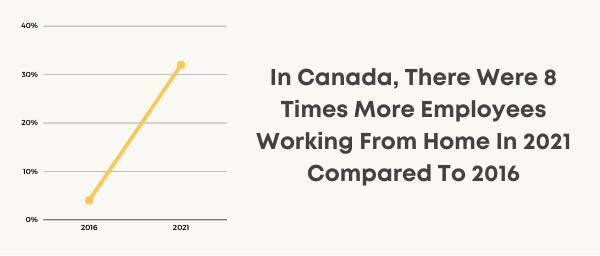

Remote Working Productivity Statistics
14. 77% of workers say they are more productive working from home than in their workplace.
One of the biggest benefits of working from home is the fact that employees working from home report higher levels of productivity. This could be due to the fact that they are not distracted by coworkers and other things in the workplace. Moreover, this is one of the working from home productivity statistics that shows how employers can benefit from offering remote work to their workers.
Source: CoSo Cloud
15. 90% of organizations report the same or increased level of productivity working from home compared to on-site.
Despite this positive result, there are several things to take into consideration here. For example, mothers working from home might be finding it harder to stay productive while working from home, compared to fathers.
Source: Mercer


16. 75% of workers find work from home less distracting.
No office chatter or loud colleagues means that working from home has another advantage. It is less distracting for three-quarters of workers, according to FlexJobs. This ultimately leads to higher productivity levels.
Source: FlexJobs
Remote Work Benefits
17. Commuting time is reduced by 62.4 million hours per day.
Employees can be way more productive without having to spend time commuting from their homes to their workplaces. As a matter of fact, over 9 billion hours were saved from the middle of March to the middle of September 2020 thanks to working from home and no need for the commute.
Source: Becker Friedman Institute for Economics
18. On average, 40 minutes are saved per day by remote employees.
By staying at home and working, individuals don’t have to waste their time traveling from their homes to their workplace and back. This can make them more focused on work and happier with their life away from work. Moreover, according to the State of Telecommuting, those who spend 50% of their time working remotely save 11 days a year by not traveling to work.
Source: Owl Labs
19. Greenhouse gas emissions are reduced by the amount of 600,000 cars with telecommuting.
As a daily commute is not necessary when working from home, pollution levels go down. This is one of the telecommuting statistics that is a great way to help the planet, and not just employees and employers.
Source: State of Telecommuting


20. The main reason employees choose to work remotely is a better work-life balance.
Work-life balance is necessary for employees to feel well mentally and physically. This means that employees want a life where they will be able to have enough free time outside of work. As a result, the greatest perk of telecommuting is having enough time to spend on activities that are not related to work daily.
Source: Owl Labs
21. Employers can save over 11,000 dollars per employee annually.
If employees are working from home, then employers don’t have to spend as much money on office spaces. Also, employees will, as a result, be less absent, more productive, and there will be less employee turnover, which will all save money in the long run.
Source: Global Workplace Analytics


22. Employees can save from 2,500 to 4,000 dollars per year when telecommuting.
By staying at home and working instead of going to the office every day, employees can also save money. This is due to spending less money on food, fuel, transport, etc. According to CoSo Cloud, 30% of employees are saving 5,240 dollars a year by telecommuting.
Source: Global Workplace Analytics
23. Working from home reduces stress for 86% of workers.
While stress is one of the biggest killers of this century, reducing it is in the interest of employees and employers. By working from home, employees can have a healthier lifestyle in general, by eating healthier, exercising, and being more relaxed in general.
Source: FlexJobs
24. Employee turnover is 25% lower for companies that allow remote work.
Remote work is very desirable for employees and when companies offer them remote work, chances are they will want to stay working in the company. As a result, companies will have less talent leaving them in the long run.
Source: Owl Labs
25. An average annual income of telecommuters is $4,000 higher than other workers.
One of the telecommuting benefits statistics shows that telecommuters also make more money than other workers. This makes it a desirable type of work.
Source: State of Telecommuting


26. For flexible working options, 21% of workers would give up some of their vacation time.
These remote workers’ statistics show that flexible work is a work benefit workers prefer to some other benefits, such as vacation time.
Source: FlexJobs
27. Flexible schedule is the greatest work benefit for 40% of workers.
Among vacation time, health insurance, and other work benefits, a flexible schedule is voted number one by 4 in 10 workers.
Source: Buffer
28. Workers who work remotely at least once a month are 24% more likely to be productive and happy.
This remote work data shows us that those who work remotely even from time to time are likely to be happier, besides being more productive. This is only one of the remote work mental health statistics, showing us that remote work can be good for the mental well-being of workers.
Source: Owl Labs
29. In 2015, employers saved 44 billion dollars by telecommuting.
One of the financial remote work benefits shows how much money companies and employers can save if they offer telecommuting to their employees. According to data from the State of Telecommuting, employers saved billions of dollars by telecommuting, even before the start of the pandemic.
Source: State of Telecommuting
30. 57% of remote workers are satisfied with their jobs, compared to 50% of office-based workers.
A CNBC survey from May 2020 shows that remote workers scored 75 out of 100 on a Workforce Happiness Index, compared to 71 out of 100 for on-site workers.
Source: CNBC
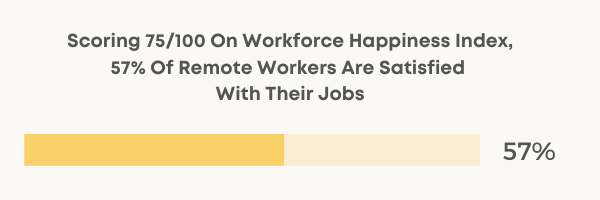

Remote Work From Home Statistics & Trends
31. 51% of employers allow their workers to officially work from home.
While 51% of employers officially allow their workers to work from home, only 27% actually allow them to. While half of the companies say they support work from home, unfortunately not all of them actually follow through.
Source: Softchoice
32. Zoom is one of the most used apps while working from home during the COVID-19 pandemic.
One of the most interesting home working statistics shows that Zoom gained the biggest popularity among companies who were working from home during the lockdowns around the world. Among its users, Zoom is popular for teachers, students, and entrepreneurs, and working professionals
Source: Zoom
33. Companies report increasing spending on web conferencing software since April 2020.
According to Statista research, companies have been investing in reliable software since the outbreak of the global pandemic. However, this also shows that web conferencing will be here to stay even after the pandemic.
Source: Statista
34. By the end of 2021, 25-30% of the workforce will be working from home.
According to a forecast by Global Workplace Analytics, between one-quarter and one-third of the workforce will be working from home by the end of 2021, for several days per week, according to working from home statistics and forecasts.
Source: Global Workplace Analytics
35. 13% of workers would like to always work from home if possible.
While 72% of those who participated in Slack research prefer hybrid work models, 13% of those workers said they would always choose to work from home if it were possible.
Source: Slack
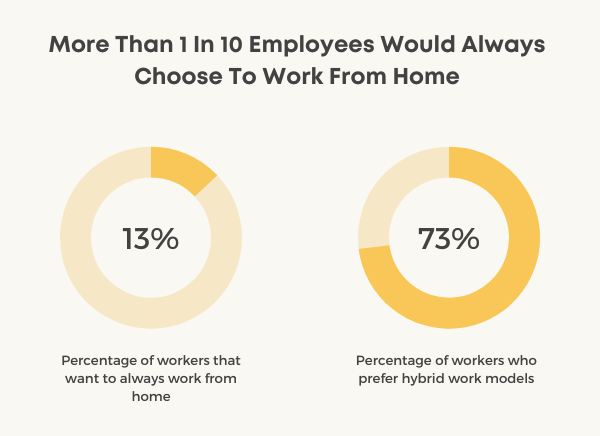

36. 75 million (or 56%) of W2 workers could work from home if their employers allowed it.
If employers allowed their workers to work from home, around 56% of W2 workers would be able to do so. This might happen in the future.
Source: Global Workplace Analytics
37. In the USA, 4.3 million people work from home at least half the time.
This makes up for 3.2% of the workforce in the United States. The same report from 2018 also says that 40% more companies in the USA offered remote work as a possibility than they did 5 years prior. Likewise, this is one of the remote working trends that show how companies cannot ignore the fact that remote work is very sought after among workers.
Source: Global Workplace Analytics
38. Small businesses are twice as likely to hire a full-time remote worker.
As workers are looking for opportunities to work from home, small businesses are offering it to them as a way to attract talent. Moreover, this is also reasonable from the perspective that small businesses then don’t have to spend money on offices and more.
Source: Owl Labs
39. 37% of jobs in the USA can be performed from home.
While business leaders predict that work from home could increase in the coming years, over one-third of all the jobs in the US could be performed from home.
Source: U.S. Bureau of Labor Statistics
40. Millennials (69% of them) would give up certain work benefits for a flexible schedule.
By 2020, millennials will make up around half of the workforce, estimates are suggesting. So, the fact that 69% of them would give up many work benefits just to be able to work from home says a lot.
Source: CBRE


Remote Work Challenges
41. Mobile phones are the biggest distraction for 56% of those who work from home.
A WFH OfficeNeedle study found out that remote workers struggle with the distraction of a mobile phone. After mobile phones, social media is a big distraction for 44% of remote workers the most. When it comes to social media, Facebook, Instagram, and Youtube are the biggest distractions.
Source: OfficeNeedle
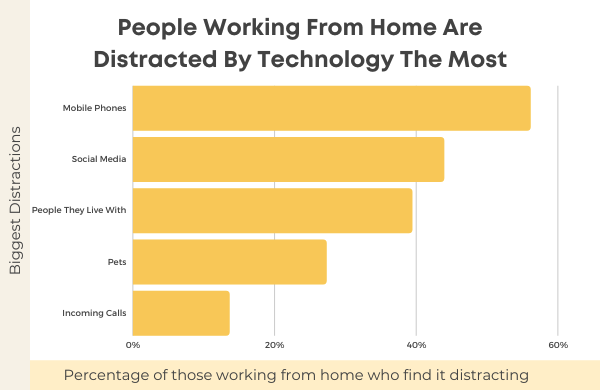

42. Unplugging after work (22%), loneliness (19%), and communication (17%) are the most challenging aspects of remote work.
The percentage of remote workers who work from home and have a problem with unplugging after work is around one-fifth. Besides overworking, those working from home may also feel more lonely than on-site workers. Finally, communication with the team is another big challenge for those working from home.
Source: Buffer
43. Brainstorming and meetings are the biggest challenges for remote work.
Brainstorming usually entails being in the same room and coming up with ideas and solutions quickly. So it comes as no surprise that it is a big challenge for the teams that work remotely. Meetings can also be a problem, especially those where strategies are planned, according to Owl Labs remote work stats.
Source: Owl Labs
44. No more than 70% of remote workers get regular training from the company.
Around 87% of remote workers get training, yet only 70% of remote workers get it from their company. Also, those who do not get training or want more will have to pay for it themselves.
Source: TalentLMS
45. According to 54% of IT professionals, remote workers pose a greater risk to security than traditional workers.
As remote workers completely depend on the Internet and technology, they are at a higher risk of cyberattacks. That is why they should receive training for it.
Source: OpenVPN
Remote Workers Statistics
46. 77% of remote workers do house chores and 67% cook during office hours.
Besides the distractions of technological nature, working from home also means that remote workers have other things to tend to during office hours. For example, the OfficeNeedle survey from June 2021 also shows that the majority of workers cook and clean when they should be working instead.
Source: OfficeNeedle
47. 44% of the parents who work from home have to tend to their children.
Children who stay at home at the same time as their parents who are working remotely demand attention and help. Especially those of younger age, so almost half of the parents who work from home have to take care of their offspring at the same time.
Source: OfficeNeedle


48. IT and Technology industry have 77% of remote workers (fully and partially), during COVID-19.
When it comes to different industries, IT and Technology have the most remote workers during the global pandemic, according to COVID remote work statistics.
Source: BCG
49. Industries with the highest number of remote workers are healthcare (15%), technology (10%), and financial services (9%).
While the industries with the most remote workers during the pandemic are IT and Technology, in general, healthcare has the highest number of remote workers.
Source: Owl Labs
50. The number of digital nomads, who are also remote workers, has more than doubled from 2018 to 2020 in the USA.
According to digital nomad statistics data from MBO Partners, the number of digital nomads in 2018 was 4.8 million. In 2019, the number rose to 7.3 million. In 2020, there were over 10.9 million digital nomads in the US alone.
Source: MBO Partners
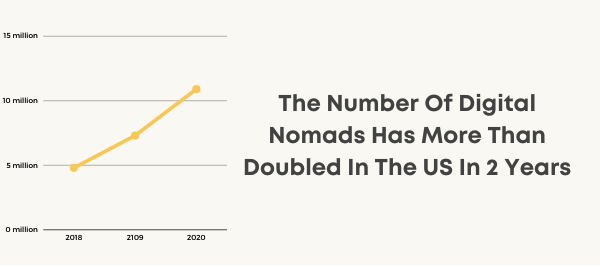

Remote Hiring Statistics – Recruiting, Talent Acquisition, And Job Retention
51. 76% of workers would stay with the same employer if they could work flexible hours.
For companies that want to retain talent, one step to moving forward is offering flexible hours. Why? Because 76% of employees report that they are willing to stay with their current employer if they offer flexible hours, according to FlexJobs remote hiring statistics.
Source: FlexJobs
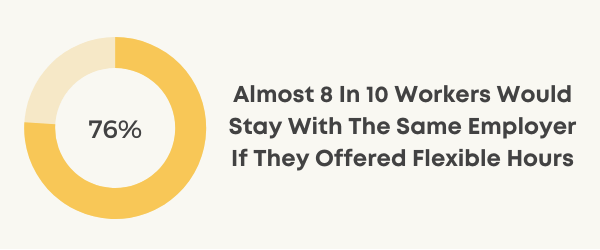

52. A work-from-home pitch helps 64% of recruiters to find talented workers.
As flexibility and remote work are very sought-after, it is not surprising that recruiters find it easier to attract talent when they offer them those benefits.
Source: IWG
53. Companies that allow remote work saw a 50% decrease in resignations in 2017.
Even before remote work was as popular as it is today, it helped companies to retain talent. Moreover, resignations were cut in half once the companies allowed for remote work, according to Stanford research data.
Source: Stanford
Real Estate & Telecommute Statistics
54. 65% would move or think about moving if they were offered a permanent remote work arrangement.
Remote work is impacting real estate. How? Well, it gives people more freedom on where they live while working. Thanks to remote work, employees are moving more across the US and even purchasing starter homes.
Source: FlexJobs
Statistics On The Future Of Remote Work
55. Employing remote workers will be normal for many teams, 85% of managers believe.
The majority of managers believe that remote work is going to become more common in the future so that most teams will have someone working remotely for them. This is to say that hybrid work is going to become the norm. Moreover, according to Gartner data, 74% of companies will shift some of their workers to work remotely permanently.
Source: TECLA
56. By 2025, 36.2 million Americans will be working fully remotely.
If this becomes true in the next three years, the rate of Americans working remotely will have increased by 16.8 million, compared to pre-pandemic.
Source: Upwork
57. Less than one in five executives want to return to the office like it was before the pandemic.
While the majority of the executives are still thinking about how wide remote work options should be, 13% of them want to get rid of the office for good.
Source: PwC
58. 55% of workers want to work remotely at least three days a week once the pandemic slows down.
While the majority of employees want to stay working remotely for the most part of the week, the majority of employers (68%) think employees should work from the office at least three days a week, to be able to maintain company culture.
Source: PwC
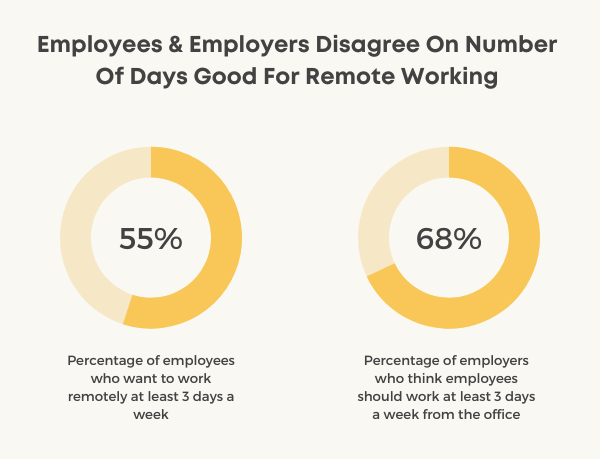

59. 65% of remote workers do not want to return to the office post-pandemic.
Looks like the majority of remote workers prefer remote work, without wishes to return to the office, even once the pandemic recedes.
Source: FlexJobs
60. 61.9% of companies are planning more remote work options in the future, due to the pandemic.
According to stats from an Upwork study of 1,500 hiring managers, 61.9% of them are planning to involve their employees in remote work more in the coming years.
Source: Upwork
Final Verdict
While these remote work statistics show what the benefits and challenges of this type of work are, it is undeniable that remote work is on the rise. Moreover, even though it was on the rise even before the pandemic, the remote work statistics before and after COVID-19 tell us that the pandemic made remote work rise even more rapidly. However, it is also causing remote work burnout. It will be interesting to continue looking out for the relationship between companies, workers, and remote work in the upcoming months and years.

































Find Us on Socials